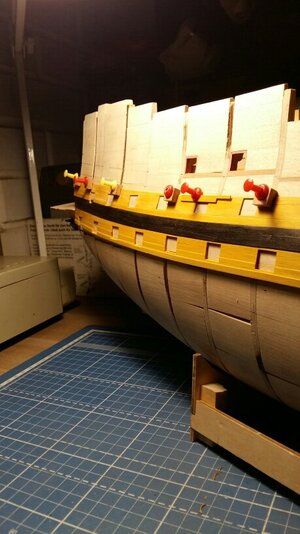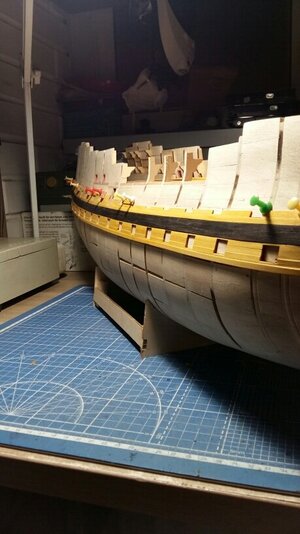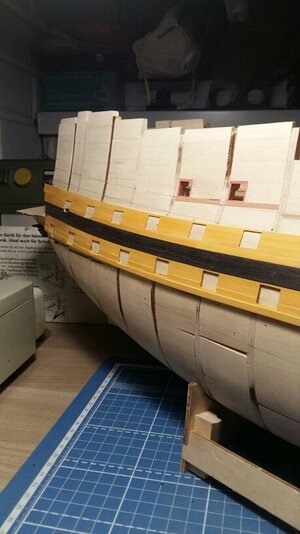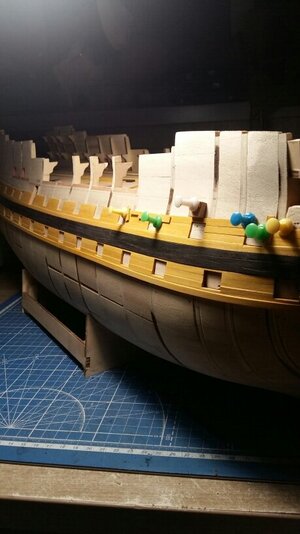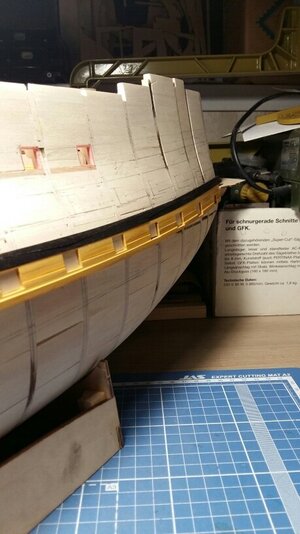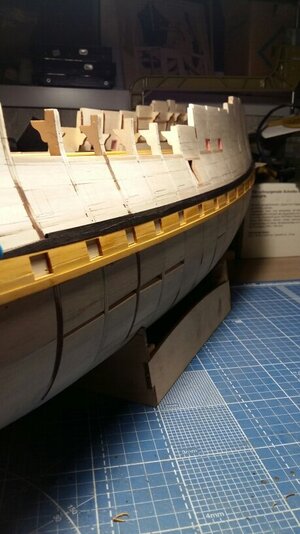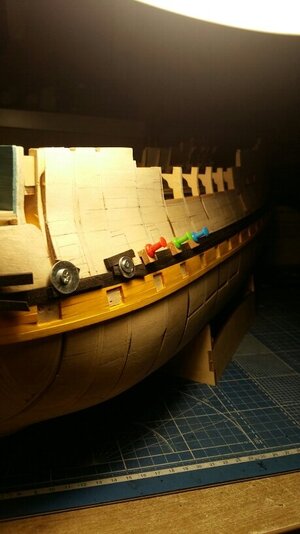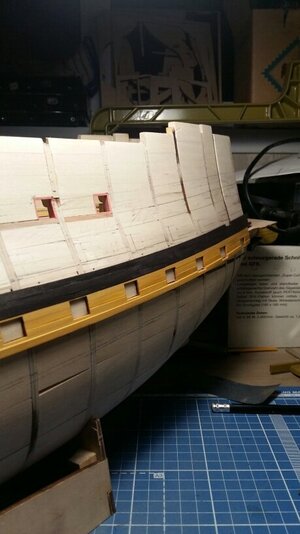Thanks, Paul. I won't say that I really like this collection of Deagostini magazines, but it's interesting to me. In addition, I assemble the model to order, and I'm not used to doing bad work. The customer is upset. In addition, he has something to compare with (the schooner Albatross and the yacht Shtandart) collected these models for him.Very nice work Sasha. I can see you enjoy this build!
You are using an out of date browser. It may not display this or other websites correctly.
You should upgrade or use an alternative browser.
You should upgrade or use an alternative browser.
Model VICTORY by Deagostini, scale 1/84
- Thread starter Alexander74
- Start date
- Watchers 85
-
- Tags
- deagostini victory
Yes Heinrich, I did not go the usual way. From the velvet up. For a long time I was looking for a line from which to start sheathing. The fact is that the version from the magazine does not at all coincide with McKay's anatomy, we had to look for something in between and similar to the original. I also use Longridge's book "The Anatomy of Nelson's Ships" in my work. Therefore, such a path is in the skin.That is extraordinary preparation for the planking. This WILL be a work of art!
I like the yellow hornbeam (that's what it is right?).
Paul, Sargei (Bibigon) has any hornbeam to choose from.I like the yellow hornbeam (that's what it is right?).
Yes. I ordered my pear from him and he sent me an example of the black. I didn't know there were other options...Paul, Sargei (Bibigon) has any hornbeam to choose from.
I don’t know whether it is a feature if the kit, but it is good recognition of the variation of plank thickness above the lower main wale. Beautiful, careful work.
The hornbeam is it pre stained or is that the natural color of the wood? Looks brilliant.Paul, Sargei (Bibigon) has any hornbeam to choose from.
I don’t think the kit comes with the variation and the black planking in the kit is also a single straight plank while here we see the Victory pattern as well. Sasha also changed the wood from birch.This is very good work Sasha.I don’t know whether it is a feature if the kit, but it is good recognition of the variation of plank thickness above the lower main wale. Beautiful, careful work.
Of course, there is no such thing in the set. They propose to sheathe the entire body with the same 5x2 mm strips and put velvet on top. I went the other way. The thickness of all planks will be according to books and anatomy. They indicate the thickness of each sheathing belt. It is more difficult, but it will be correct from a historical point of view.I don’t know whether it is a feature if the kit, but it is good recognition of the variation of plank thickness above the lower main wale. Beautiful, careful work.
As far as I know, natural hornbeam is white. You can see how he looks out here: https://www.shipsofscale.com/gallery/alexander74/shtandart/index.htmlThe hornbeam is it pre stained or is that the natural color of the wood? Looks brilliant.
Below the waterline is the natural color of the hornbeam, above it is black.
Different colors of hornbeam (yellow, red, blue, green, black) are obtained by coloring.
Here is an excerpt from an article about this tree:
So, a completely logical question arises, how can a hornbeam, which has a light color, replace black woods? It's simple - it is painted black. But they do not just paint its surface on the finished product, but use a special technology, with the help of which the tree is painted through. For painting, nigrosines are used - black dyes, which are obtained by heating aniline and nitrobenzene with ferric chloride. In addition to black, the hornbeam is also painted in other colors, for example, red, green, yellow, etc. After polishing, the color is very rich and, due to the poor texture, uniform.
So, if the species of wood is not of fundamental importance for you, then you can safely use the black hornbeam instead of exotic African black species. No one will notice the visual difference, and although it loses in terms of physical properties, its characteristics are more than enough in any field of application.
Greetings. And there were no quarters at the ports, judging by the photo of the current VICTORI. The ports of the lower two decks are planned to be closed, there will be only covers. If open ports were planned, then I would have already finished the casing. And so you have to fit each rail near the port. That's why it's so slow.Привет соотечественник.Alexander is a very beautiful combination of colors of the cladding.But the question is how will you cut through the ports?If you are already gluing the finishing trim.Will there be quarters?
Wrong, there are quarters. But the lower two decks will still be closed.
Supe
As far as I know, natural hornbeam is white. You can see how he looks out here: https://www.shipsofscale.com/gallery/alexander74/shtandart/index.html
Below the waterline is the natural color of the hornbeam, above it is black.
Different colors of hornbeam (yellow, red, blue, green, black) are obtained by coloring.
Here is an excerpt from an article about this tree:
So, a completely logical question arises, how can a hornbeam, which has a light color, replace black woods? It's simple - it is painted black. But they do not just paint its surface on the finished product, but use a special technology, with the help of which the tree is painted through. For painting, nigrosines are used - black dyes, which are obtained by heating aniline and nitrobenzene with ferric chloride. In addition to black, the hornbeam is also painted in other colors, for example, red, green, yellow, etc. After polishing, the color is very rich and, due to the poor texture, uniform.
So, if the species of wood is not of fundamental importance for you, then you can safely use the black hornbeam instead of exotic African black species. No one will notice the visual difference, and although it loses in terms of physical properties, its characteristics are more than enough in any field of application
super interesting and informative- ThanksAs far as I know, natural hornbeam is white. You can see how he looks out here: https://www.shipsofscale.com/gallery/alexander74/shtandart/index.html
Below the waterline is the natural color of the hornbeam, above it is black.
Different colors of hornbeam (yellow, red, blue, green, black) are obtained by coloring.
Here is an excerpt from an article about this tree:
So, a completely logical question arises, how can a hornbeam, which has a light color, replace black woods? It's simple - it is painted black. But they do not just paint its surface on the finished product, but use a special technology, with the help of which the tree is painted through. For painting, nigrosines are used - black dyes, which are obtained by heating aniline and nitrobenzene with ferric chloride. In addition to black, the hornbeam is also painted in other colors, for example, red, green, yellow, etc. After polishing, the color is very rich and, due to the poor texture, uniform.
So, if the species of wood is not of fundamental importance for you, then you can safely use the black hornbeam instead of exotic African black species. No one will notice the visual difference, and although it loses in terms of physical properties, its characteristics are more than enough in any field of application.
I've just caught up with this build now, from the beginning, and I feel quite exhausted now. It has been a journey and an education, so much to take away from all of this. A privilege to watch and follow your progress, Sasha, and I look forward to what is yet to come 
- Mark

- Mark
Thanks Mark. I will try to continue showing the stages of assembling this model. Now the work is going slowly, plating near the gun ports takes a long time. In addition, my circular saw blade is dull, I ordered new ones, I'm waiting for delivery. After delivery I will continue with renewed vigorI've just caught up with this build now, from the beginning, and I feel quite exhausted now. It has been a journey and an education, so much to take away from all of this. A privilege to watch and follow your progress, Sasha, and I look forward to what is yet to come
- Mark
WOW! This going to be a gorgeous build! Look at the quality of that wood!


